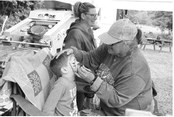July is UV Safety Month: No suntan is a safe tan


A little sunlight is good for you. Your body uses it to make vitamin D, which keeps bones strong. But it doesn’t take long for the sun’s ultraviolet (UV) rays to start causing damage. That damage can lead to premature wrinkles, age spots and even skin cancer, the most common type of cancer in the United States.
“Many people go into summer with the goal of getting a suntan, not realizing how incredibly damaging it is to their skin,” says Nikole Larkin, Nurse Practitioner at Aspirus Plastic Surgery & Aesthetics. “In fact, there’s no such thing as a safe tan and we should be doing what we can to protect our skin from getting one.”
According to the U.S. Food and Drug Administration (FDA), when the sun’s UV rays beat down, your skin tries to protect itself by kicking production of a pigment called melanin into high gear. The added melanin provides a sun protection factor (SPF) of about 2 to 4—far below the minimum 30 SPF that the American Cancer Society (ACS) recommends for sun protection. It’s the added melanin that causes your skin to darken and that tan signals that you were out in the sun too long.
Reduce sun exposure and skin cancer risk with these top tips from the ACS and the American Academy of Dermatology (AAD): Seek shade - Don't stay out in direct sunlight for too long. The sun's rays are strongest between 10 a.m. and 4 p.m. That's the time to stay in the shade. A good rule of thumb: If your shadow is shorter than you are, seek shade.
Put on a hat - A hat with a 2- to 3-inch brim all around is a good choice, as is a shade cap (a baseball cap with fabric down the sides and back). Baseball caps and straw hats offer less protection.
Wear sunglasses - Melanoma can develop in the eyes, so choose glasses that block 99% to 100% of UV rays and wear them every day. Darker glasses don't necessarily mean more protection—check the label to be sure.
Wear protective clothing - Cover as much of your skin as possible. Dark colors and tightly woven fabrics offer the most protection. To get an idea of how protective clothing is, hold it up to bright light. If light comes through, the sun's rays can get through too.
Use sunscreen - Choose a broad-spectrum, water-resistant sunscreen with a sun protection factor (SPF) of 30 or more. Apply it generously to all exposed skin before you go outside. Reapply at least every 2 hours and after swimming or sweating. You should follow these rules even when it's cloudy.
Medical grade sunscreen and other skincare products are available for purchase at Aspirus Plastic Surgery & Aesthetics.
Use lip balm - Protect your lips by wearing lip balm that contains sunscreen.
“Taking extra precautions now can give long-term benefits down the road, such as maintaining a more youthful appearance and decreasing your risk of skin cancers,” says Larkin.







